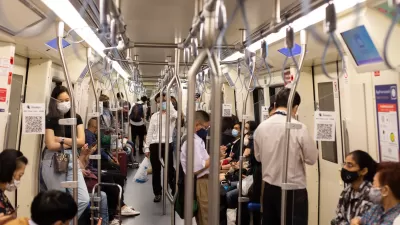Welcome to the age of "Dashboard Governance"—when a good user interface offers the potential for performance advantages to city management.
Shannon Mattern describes the adoption of "Mission Control" style urban dashboards in city governments all over the world. Mattern introduces the idea of the urban dashboard at the beginning of the long article:
"We know what rocket science looks like in the movies: a windowless bunker filled with blinking consoles, swivel chairs, and shirt-sleeved men in headsets nonchalantly relaying updates from “Houston” to outer space. Lately, that vision of Mission Control has taken over City Hall. NASA meets Copacabana, proclaimed the New York Times, hailing Rio de Janeiro’s Operations Center as a 'potentially lucrative experiment that could shape the future of cities around the world.'"
Mattern lists some of the governments that have adopted futuristic control rooms, such as Baltimore, London, Michigan, and the United Kingdom (the Boston Globe reported last year that new(ish) Boston Mayor Martin J. Walsh is also a believer).
As for the implications of such technology, Mattern describes the urban dashboard as a key indicator of an evolving understanding about cities: "They don’t seek merely seek [sic] to display information about a system but to generate insights that human analysts use to change that system — to render it more efficient or sustainable or profitable, depending upon whatever qualities are valued."
Mattern goes on to provide a history of the rise of urban dashboards. Included in the number of the most recent experiments, for example is the work of a "group of Europen cities…collaborating on the development of urbanAPI, which proposes to help planners engage citizens in making decisions about urban development."
The long form article includes a lot more on the history and potential of dashboards and their relevance to the concerns of planning-related fields.
FULL STORY: Mission Control: A History of the Urban Dashboard

Alabama: Trump Terminates Settlements for Black Communities Harmed By Raw Sewage
Trump deemed the landmark civil rights agreement “illegal DEI and environmental justice policy.”

Planetizen Federal Action Tracker
A weekly monitor of how Trump’s orders and actions are impacting planners and planning in America.

The 120 Year Old Tiny Home Villages That Sheltered San Francisco’s Earthquake Refugees
More than a century ago, San Francisco mobilized to house thousands of residents displaced by the 1906 earthquake. Could their strategy offer a model for the present?

Indy Neighborhood Group Builds Temporary Multi-Use Path
Community members, aided in part by funding from the city, repurposed a vehicle lane to create a protected bike and pedestrian path for the summer season.

Congestion Pricing Drops Holland Tunnel Delays by 65 Percent
New York City’s contentious tolling program has yielded improved traffic and roughly $100 million in revenue for the MTA.

In Both Crashes and Crime, Public Transportation is Far Safer than Driving
Contrary to popular assumptions, public transportation has far lower crash and crime rates than automobile travel. For safer communities, improve and encourage transit travel.
Urban Design for Planners 1: Software Tools
This six-course series explores essential urban design concepts using open source software and equips planners with the tools they need to participate fully in the urban design process.
Planning for Universal Design
Learn the tools for implementing Universal Design in planning regulations.
Clanton & Associates, Inc.
Jessamine County Fiscal Court
Institute for Housing and Urban Development Studies (IHS)
City of Grandview
Harvard GSD Executive Education
Toledo-Lucas County Plan Commissions
Salt Lake City
NYU Wagner Graduate School of Public Service





























